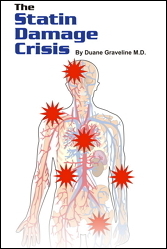The Baycol Disaster
The maker of Baycol ( cerivastatin ) a popular cholesterol-lowering drug used by about 700,000 Americans, voluntarily pulled the medicine off the market August 8, 2001 because of numerous deaths associated with its use.
Baycol was just another statin introduced by a drug company to insure market access in the thriving cholesterol lowering industry.
As such it is an HMG-Co-enzyme A reductase inhibitor, as are all the other Statins. Although each of these Statins differ, with a "methyl group here and an hydroxy group there", they all inhibit the enzyme reductase.
As a result of this molecular variation, the side effect profiles of such drugs can vary considerably even though they are generally similar.
Bayer AG, the German company that makes Baycol, introduced the drug under the trade name Baycol in January 1998. The first death was reported in January 2000, with the number of complications rising markedly when a high-dose pill was introduced.
Officials at the Food and Drug Administration (FDA) hesitated about taking action until some 60 users of Baycol had died of the dreaded complication, rhabdomyolysis. The elderly and women appeared to be at higher than usual risk for this complication.
I ask why the FDA allowed 60 deaths to accumulate in their adverse drug report lists before finally being galvanized into action to do a simple recall action. This is not my idea of a rapid response capability in an agency charged with the responsibility of protecting the public from pharmaceutical industry excesses and errors.
Yes, concurrent use of the cholesterol lowering drug, gemfibrizol, and Baycol dosing in the high range were contributing factors in some of these deaths; the issue is why the incredible delay? Would not 10 deaths have sufficed? or perhaps three, before cautionary signals were sent out to prescribing physicians who are absolutely dependent upon such guidelines if they are to perform their tasks of health maintenance?
Rhabdomyolysis is the most severe form of myopathy. Many statin users had come to expect myopathy, for despite drug company promotional literature that this muscle "ache and pain" inflammatory nuisance occurred in less than 2% of statin users, the actual incidence rate is much closer to 20%.
In rhabdomyolysis, muscle inflammation progresses to the point of actual breakdown of muscle cells, spilling their contents into the blood stream where it progressively blocks delicate kidney tubules. Death is from kidney failure.
For patients taking the more established statin drugs (lovastatin, simvastatin, pravastatin, and atorvastatin) FDA recommendations have not changed. Statin users must be advised that the withdrawal of Baycol has not eliminated the rhabdomyolysis problem. This dread and frequently fatal condition still is occurring, often masquerading as kidney failure on death certificates.
All aches and pains in statin users should be reported promptly to their doctors. Usually a simple blood test for muscle enzymes can detect when myopathy is "getting serious" however enzyme elevation comes late in many cases of myopathy and rather sudden evolution of simple inflammation into muscle cell breakdown can occur.
Duane Graveline MD MPH
Former USAF Flight Surgeon
Former NASA Astronaut
Retired Family Doctor






